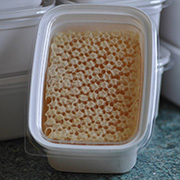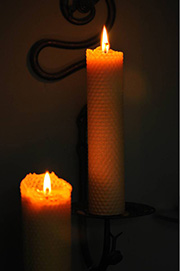| |
| |
 |
|
 |
| |
|
|
|
| |
 |
| |
| Where To Find Us |
 |
 |
| |
| Product Range |
 |
 |
 |
| |
 |
| |
 |
| |
 |
| |
 |
| |
 |
 |
| |
 |
| |
|
|
| So what is honey? |
|
Honey is a complete food for bees, containing a range of natural sugars, amino acids, enzymes, vitamins, antioxidants and small traces of pollen and protein. It also has a number of beneficial health qualities and medicinal applications. Typical honey contains fructose, glucose, and sucrose as well as a range of other sugars at varying levels such as maltose, raffinose, dextrose etc. and around 18% water.
As Bees follow nature’s seasonal cycle they are totally dependent upon the weather for their collection of nectar and pollen, so honey is not produced all year round. And because of Cornwall’s various localised climatic conditions honey crops are not guaranteed. At best there are two honey flows in a season, late spring and summer. Sometimes you may get some Heather late on in the season. |
| |
| So how is honey made… |
| |
| The bees visit the flowers collecting the nectar and pollen. They process the nectar through a special honey stomach and then convert this into honey by repeatedly refining and adding their own special mixes of enzymes which fracture the raw nectars down into the complex range of ingredients found in honey. The air conditioning provided by the bees constantly fanning their wings, helps to evaporates the excess moisture out of the honey, ensuring it ripens. |
| |
| … and how do they make the comb? |
| |
| It’s simple for the bees as at certain points in their life, nature has given them the capacity to make wax. They do this by eating lots of honey and pollen first, and then by clustering together to raise their body temperature their wax glands start to secret natural beeswax.
This they magically mould into comb. It’s this new natural honeycomb that we sell in our Comb honey trays or jars of Chunk Honey, meaning you get the purest product of the bees.
In a good year a colony could produce up to 100kg of honey, around 60% of which it will consume to make the bees & keep it self sustained for the future. |
| |
| So how does the comb get into the jar? |
| |
| Natural comb-honey is prepared by the bees. When the honey crop is harvested this comb is separated from the main honey for extraction.
The main honey crop is extracted first using an extractor which spins the honey out of the combs. (Did you know all the cells in the comb are slightly inverted so as to prevent the honey from running out?)
The honey is then sieved to get the bits of wax out and then left to settle for a period of days to allow the remaining air bubbles to rise to form froth on the top, which is skimmed off. The honey is now ready for bottling.
Now its time to prepare the comb for putting into jars. The natural honey comb is wiped clean & inspected, and then it’s carefully cut out of the frames and placed on a glass cutting board.
This is then sliced into pieces using a palate knife ready for the jar. It is then carefully picked up and slid into the jar. These are then stacked ready to be filled with honey. |
| |
|
| |
|
|
|
|
|
| |
Important Note:
This site is still under construction - we are busy with the honey harvest !
Some of the links to our products above don't work yet - but they will in due course.
If you want to order anything simply call or email us – we’ll be pleased to help. |
|
| |
| Home |
About Us |
Our Honey |
Our Beeswax |
Market Dates |
Stockists |
Classes |
Contact Us |
|
|
| |
|
|



